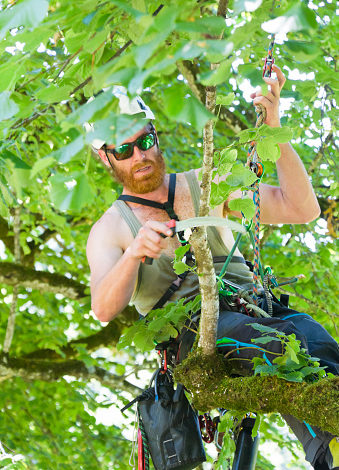Pruning trees Sydney



Pruning fruit trees is an art and a science. It is important for the health of the tree, for larger fruit, and for easy picking. The first shaping pruning on a young tree affects the overall shape, production and ease of picking of the tree during its life.It is important to keep these things in mind when pruning your fruit trees. You need to look at your trees with an artistic eye and visualize the tree in one year, two years, and as a mature tree.
You need to understand the science of pruning trees to know the parts of the tree and what each pruning does as it grows. A simple example of this is the difference between a fruit bud, also called a fruiting shoot, which will bear fruit, and a leaf bud, which will produce a leaf or twig that will not bear fruit.
It is important to know how the branch structure grows and what the difference is between a side branch, the main branch, smaller side branches and water shoots, also called offshoots.
Before pruning:
Before you begin pruning, walk around your tree and look at it from all angles to get an idea of how you want your tree to look and what general design ideas you have for the tree. Remember that your tree is a living thing and the cuts you make today will determine its shape for years to come. This is especially true for young trees in their developmental stages.
Think openness, sun, great fruit and good ladder sets.
Pruning methods:
There are three basic pruning methods.
1-Open center, modified center trunk, and center trunk.
It is important to choose your tree pruning Sydney when you plant your fruit tree because the first cuts are very formative. If you are pruning an established fruit tree, prune according to the established system.
2-Open center pruning
Open center pruning is used primarily on stone fruit such as peaches, nectarines, and apricots. It can also be used on apples, cherries, and plums.
3-Central training pruning is used on apple and pear trees and often on nut trees.
Modified leading shoot pruning has one main shoot and three or four side branches that are also equal so that these scaffold branches are about the same size as the main shoot.
Types of pruning:
Thinning pruning involves cutting back an entire shoot or branch to a lateral or scaffold branch.
Head pruning removes only the terminal portion of a shoot. This type of pruning encourages the growth of flower buds as well as several terminal buds below the cut.
Large cuts, also called bench cuts, are used to remove vigorous, upright shoots back to the outward growing side branches. Bench cuts are used to open up the center of the tree. They can also be used to remove excessive scaffold branches caused by improper pruning of young trees.
Careful pruning will help the tree heal quickly. Cuts should be flush with the adjacent branch without leaving stumps. Also, large horizontal cuts should be angled slightly to prevent water from settling on the cut surface, as this leads to rot and disease.
Tools of the Trade
Smooth, clean cuts heal quickly and minimize the likelihood of rot and disease. Before each cut, familiarize yourself with the different types of pruning tools, their uses, and limitations. Make sure your equipment is properly adjusted, sharp, and in good condition.



